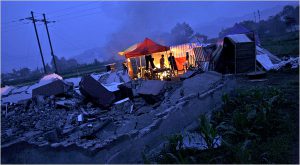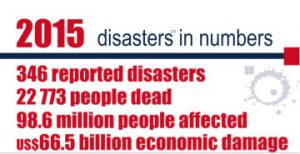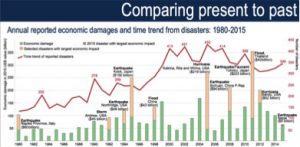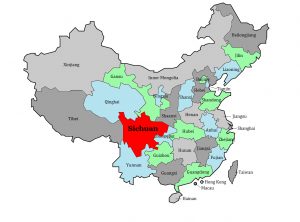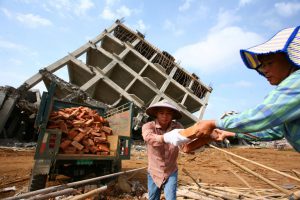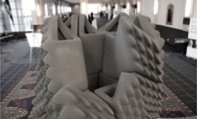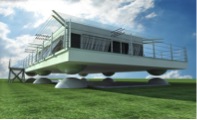Architecture as a ‘Safe Haven’
Fig. 1. “China Struggles to Shelter Millions of Quake’s Homeless” (David Barboza, New York Times News Paper. Last modified May 26,2008, http://www.nytimes.com/2008/05/26/world/asia/26china.html)Architecture and natural calamities, there needs to be a permanent place for people to heal from psychological and physiological trauma post disaster. This Architecture should cater for calamities and be sustainable, using mostly local materials regional and typical to the area e.g. bricks, bamboo, clay. This building would be public, where resources are stocked to provide temporary shelter, first aid and food for people when needed, but on the day-to-day, functions as any other building would. This building prototype would hopefully also influence and be a design standard for future projects. Disasters and natural calamities have been increasing exponentially in the past two decades, with rising numbers of fatalities after each event and more people becoming displaced. The reasons behind the dramatic changes of natural activities, are due to various factors; one being the exhausting of natural materials, burning coal for example overtime thins the stratosphere of earth, which has resulted in the process of global warming, the suns rays are able to permeate easier than twenty years ago. More drastic changes in the Earths structure are predicted to occur even more frequently for the next ten years to come. Our exponential increase in energy use will result in more natural disasters, the continual trend will only lead to the exhaustion of natural resources that we have benefited from for centuries with certain regions around the world that will have to face the consequences. Fig. 2.“2015 disasters in numbers” (International Disaster Database, The United Nations office for disaster risk reduction et al. Last modified January 25,2016, http://www.unisdr.org/files/47804_2015disastertrendsinfographic.pdf)Fig. 3.“2015 disasters in numbers” (International Disaster Database, The United Nations office for disaster risk reduction et al. Last modified January 25,2016, http://www.unisdr.org/files/47804_2015disastertrendsinfographic.pdf)As Architects, we can have a larger role in helping combat primary and secondary effects of natural disasters and raise awareness in promoting architecture that can resist these catastrophic movements. By providing a permanent shelter, a building for people to recover physically and mentally, is the potential goal. This new type of Architecture would need to be sustainable for the long term as well as immediate, with opportunities of reusing and recycling certain and suitable materials. Architectural design and the construction of buildings have become much more advanced over the past two decades because of technological advancements, from these advancements; we should be designing more sensitively to current issues. I will focus the scope of my thesis to China, in particular Wenchuan, Sichuan, located in the Centre of China. I have chosen Sichuan to be the testing ground for this project because they’ve suffered a catastrophic Earthquake with a magnitude of 8.0 back in 2008 that took the lives of 87,000 people, hundreds of thousands of people were also injured, with a large proportion being children. Many buildings collapsed and had to be rebuilt, which was unsustainable, however even the rebuilding of the infrastructures were seemingly similar to those that had collapsed during the event of the earthquake, which is not a useful redevelopment strategy. Since the improvements of building designs and construction within this region post disaster have been incremental, should an earthquake occur again, catastrophe may repeat itself. Prevention and preparedness is ideal, the aim is to figure out a better solution to reduce damage. Fig. 4.“China Sichuan location map” (Map of China, Last modified 2016, http://mapsof.net/china/china-sichuan-location-map)The ‘tofu’ buildings of Sichuan that caused the deaths of thousands, including young children in schools collapsed into piles of rubble. The mountainous debris from the dilapidated building suffocated and crushed anyone that was present in the building at the time of the earthquake. Many buildings and infrastructures toppled over as a whole, it was as though the structural support system was non-existent. The brief science behind the large Sichuan earthquake; the area sits between two tectonic plates and the deformation of the area caused the collision between the plates, resulting in an earthquake. Millions of people were still homeless one year after the earthquake, it has taken the province over 5 years to rebuild the affected areas. Fig. 5.“China’s war on illegal buildings” (Travis Daub, PBS Newshour. Last modified August 17,2010, http://www.unisdr.org/files/47804_2015disastertrendsinfographic.pdf)The second challenge for this project would be, the need to design for a hostile environment; cold winters, hot summers, flat plains increases the risk of flooding, landslides and irrigation issues have been reported in recent years and Sichuan is evidently also prone to earthquakes. When deciding on the location of the site in Sichuan, accessibility is an important factor, there needs to be space for helipads, roads for car, relatively central (be easy to reach), so when in need of help, care packages can be received easily during the event of a disaster. Designing and building sustainable architecture that can withstand and sustain certain calamities should become a mandatory practice in the field of architecture because the changing climates are exposing areas to new risks. Thus practical designs with modern methods should be incorporated to stand the test of time. It could be a matter of extra re-enforcement in sheer walls or deeper and wider piles in the foundation systems, but being sustainable designing with elements of resilience is essential so we are reducing our consumption of materials and natural resources in the long term. Outline of research:
Architects and their projects as precedence:
As Architectural designers, we are limited to the extent of which we can design to withstand natural disasters, but from studies done by engineers as well, it would be helpful to understand the perspectives of those from different industries hoping to combat the same issues I am passionate about exploring, understanding and developing. Eventually developing innovative and Architectural solutions to respond to current environmental and social issues.
Fig. 6.“The Quake column” (Ronald Rael, Virginia San Fratello. Last modified N/A, http://www.emergingobjects.com/project/quake-column/) |
